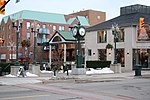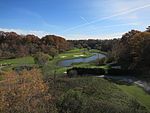White Oaks Secondary School
White Oaks Secondary School (WOSS) is a secondary school located in Oakville, Ontario, Canada. The school has north and south campuses, across the road from each other. The north campus used to be attended by students who had different levels and types of capabilities than those of the south campus. The school now acts as a whole, and students can take classes at North or South campus. The north campus offers hands-on technical programs such as hairdressing, child care, autobody and carpentry, as well as classes for students with a wide range of disabilities, and English Language Learner programs (ELL), and is the location for recognized Ontario Youth Apprenticeship Programs (OYAP) and the Ford Academy of Manufacturing Sciences (FAMS). White Oaks also offers French at the immersion level, as well as the International Baccalaureate Diploma programme. In the Fraser Institute's report on Ontario schools for the 2012-2013 year, the school was ranked 39 out of 740 secondary schools with an overall rating of 8.3/10.
Excerpt from the Wikipedia article White Oaks Secondary School (License: CC BY-SA 3.0, Authors).White Oaks Secondary School
Montclair Drive, Oakville
Geographical coordinates (GPS) Address Phone number Website Nearby Places Show on map
Geographical coordinates (GPS)
| Latitude | Longitude |
|---|---|
| N 43.463333333333 ° | E -79.701388888889 ° |
Address
White Oaks High School
Montclair Drive 1330
L6H 1Z5 Oakville
Ontario, Canada
Open on Google Maps






